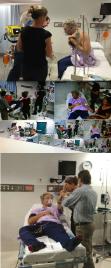Educators seek best simulation tools for cardiac event training
Published on 28 February, 2013
Simulations training for recognising and responding to the patient who is deteriorating in hospitals has relied on the availability of expensive high-fidelity simulation training centres...
Now researchers are comparing another simulation system that combines the use of a masked educator playing the role of a patient (MASK-EDTM simulation) with a simulated monitor/defibrillator (iSimulateTM).

LINK for larger images. Educators are seeking the best simulation tools for cardiac event training
To ensure realism without harming the learner, twin iPads are used with iSimulate software to mimic how the paddles and monitors respond under various conditions.
Research leader Associate Professor Trudy Dwyer says the CQUniversity study is being carried out in partnership with staff from Queensland Health, using the innovative MASK-EDTM simulation package and the iSimulate monitor/defibrillator.
To gauge effectiveness of the ‘masked educator' simulations, nurse educators, nursing and medical students and doctors from various departments at Rockhampton Hospital have been trying out the system.
Key researchers include Assoc Prof Dwyer, Deb Austen and Professor Kerry Reid-Searl from CQUniversity and Michael Guerin and Matthew Johnson from Rockhampton Hospital.
"High-fidelity manikins offer good feedback for cardiac event training but they can cost up to $150,000, lack realism and can be difficult to transport," Assoc Prof Dwyer says.
"We are comparing the cost and effectiveness of using the masked educator along with the iSimulate platform.
"The aim is to pilot a new teaching simulation method for educating nurses and doctors in recognising and responding to the deteriorating patient.
"The significance is that unplanned deaths and adverse events in hospitals are often preceded by a measurable decline in the patient's condition that has either gone unnoticed or unreported. Early detection of the deteriorating patient, initiating a timely response and effective action can save lives."
Assoc Prof Dwyer says that numerous healthcare organisations (including the CQ Hospital and Health Service) have invested in high-fidelity simulation (HFS) rapid response training centres.
"The cost limitations and expertise required to ‘coordinate' these high-fidelity simulation laboratories are challenging and limiting their use as a teaching learning method, particularly in rural settings.
"The simple, yet effective simulation approach, will be tested to determine its effectiveness as a training approach.
"The possible outcomes include identifying that this approach is effective and can be an option for mobilising effective simulation scenarios in different clinical contexts, including rural and remote, without huge expenses in time or money."

